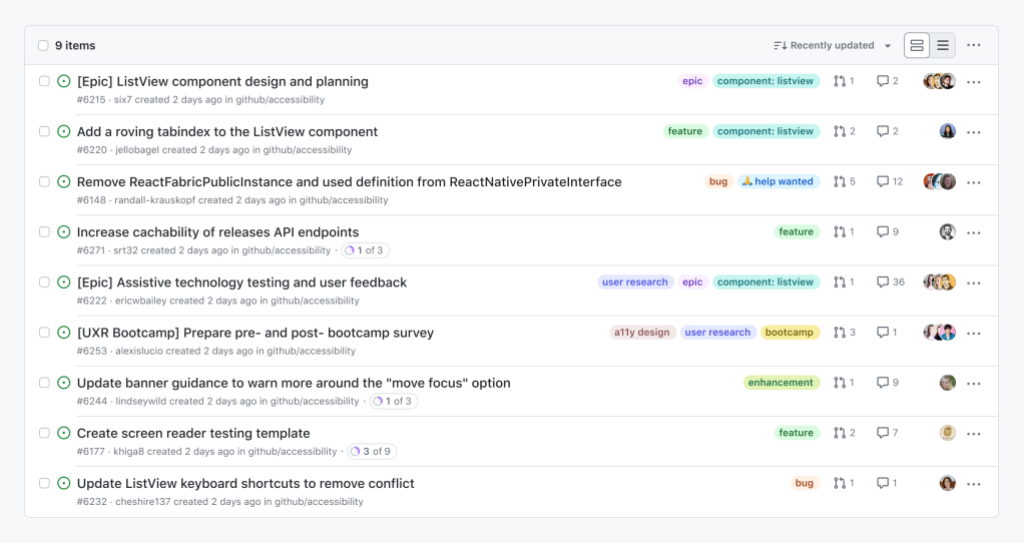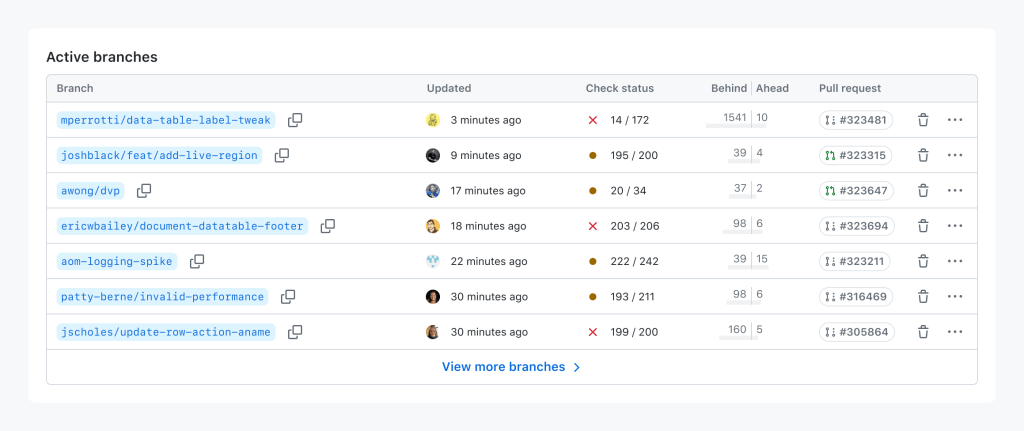Please visit accessibility.github.com to learn more and share feedback on our accessibility community discussion page.
How we’re building more inclusive and accessible components at GitHub
We’ve made improvements to the way users of assistive technology can interact with and navigate lists of issues and pull requests and tables across GitHub.com.

One of GitHub’s core values is Diverse and Inclusive. It is a guiding thought for how we operate, reminding us that GitHub serves a developer community that spans a wide range of geography and ability.
Putting diversity and inclusivity into practice means incorporating a wide range of perspectives into our work. To that point, disability and accessibility are an integral part of our efforts.
This consideration has been instrumental in crafting resilient, accessible components at GitHub. These components, in turn, help to guarantee that our experiences work regardless how they are interacted with.
Using GitHub should be efficient and intuitive, regardless of your device, circumstance, or ability. To that point, we have been working on improving the accessibility of our lists of issues and pull requests, as well as our information tables.
Our list of issues and pull requests are some of the most high-traffic experiences we have on GitHub. For many, it is the “homepage” of their open source projects, a jumping off point for conducting and managing work.
Our tables help to communicate, and facilitate taking action with confidence on complicated information relationships. These experiences are workhorses, helping to communicate information about branches, repositories, secrets, attestations, configurations, internal documentation, etc.
Nothing about us without us
Before we discuss the particulars of these updates, I would like to call attention to the most important aspect of the work: direct participation of, and input from daily assistive technology users.
Disabled people’s direct involvement in the inception, design, and development stages is indispensable. It’s crucial for us to go beyond compliance and weave these practices into the core of our organization. Only by doing so can we create genuinely inclusive experiences.
With this context established, we can now talk about how this process manifests in component work.
Improvements we’re making to lists of issues and pull requests

Lists of issues and pull requests will continue to support methods of navigation via assistive technology that you may already be familiar with—making experiences consistent and predictable is a huge and often overlooked aspect of the work.
In addition, these lists will soon be updated to also have:
- A dedicated subheading for quickly navigating to the list itself.
- A dedicated subheading per issue or pull request.
- List and list item screen reader keyboard shortcut support.
- Arrow keys and Home/End to quickly move through each list item.
- Focus management that allows using Tab to explore individual list item content.
- Support for Space keypresses for selecting list items, and Enter for navigating to the issue or pull request the list item links to.
This allows a wide range of assistive technologies to efficiently navigate, and act on these experiences.
Improvements we’re making to tables

We are in the process of replacing one-off table implementations with a dedicated Primer component.
Primer-derived tables help provide consistency and predictability. This is important for expected table navigation, but also applies for other table-related experiences, such as loading content, sorting and pagination requests, and bulk and row-level actions.
At the time of this blog post’s publishing, there are 75 bespoke tables that have been replaced with the Primer component, spread across all of GitHub.
The reason for this quiet success has been due entirely to close collaboration with both our disabled partners and our design system experts. This collaboration helped to ensure:
- The new table experiences were seamlessly integrated.
- Doing so, improved and enhanced the underlying assistive technology experience.
Progress over perfection
Meryl K. Evans’ Progress Over Perfection philosophy heavily influenced how we approached this work.
Accessibility is never done. Part of our dedication to this work is understanding that it will grow and change to meet the needs of the people who rely on it. This means making positive, iterative change based on feedback from the community GitHub serves.
More to come
Tables will continue to be updated, and the lists should be released publicly soon. Beyond that, we’re excited about the changes we’re making to improve GitHub’s accessibility. This includes both our services and also our internal culture.
We hope that these components, and the process that led to their creation, help you as both part of our developer community and as people who build the world’s software.
Tags:
Written by
Related posts

How GitHub engineers tackle platform problems
Our best practices for quickly identifying, resolving, and preventing issues at scale.

GitHub Issues search now supports nested queries and boolean operators: Here’s how we (re)built it
Plus, considerations in updating one of GitHub’s oldest and most heavily used features.

Design system annotations, part 2: Advanced methods of annotating components
How to build custom annotations for your design system components or use Figma’s Code Connect to help capture important accessibility details before development.